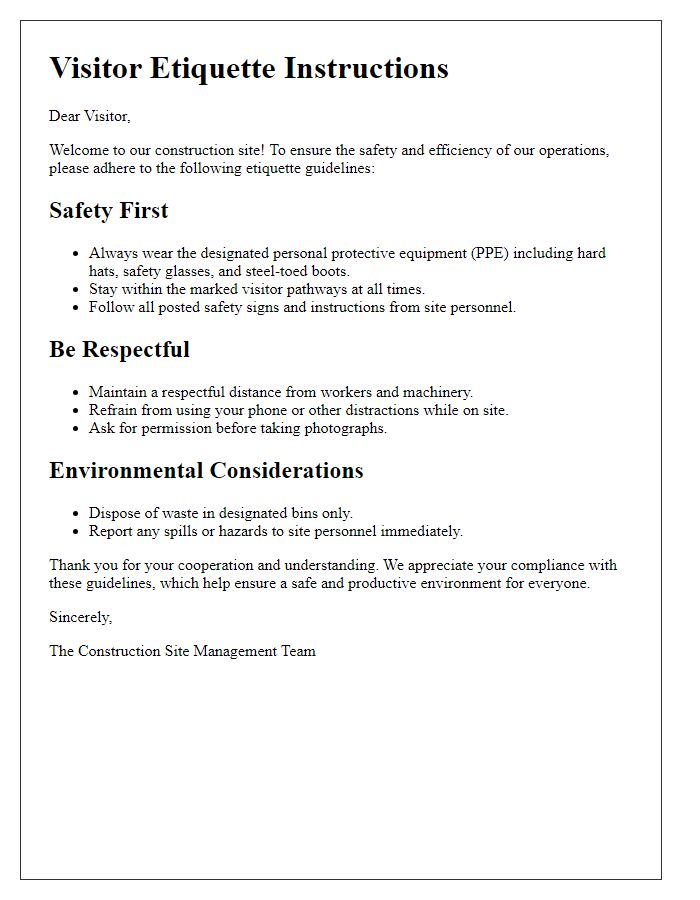Welcome to our guide on construction site visitor protocols! In the dynamic world of construction, ensuring safety and smooth operations is crucial, and having a clear visitor protocol is a vital component. This article will walk you through the essential guidelines for anyone visiting a construction site, emphasizing the importance of safety and communication. So, let's dive in and explore the best practices to keep everyone safe while on-site!

Entrance Requirements
Construction site visitor protocols establish specific entrance requirements to ensure safety and compliance. All visitors must present valid identification, which may include a government-issued photo ID such as a driver's license or passport. Visitors must wear appropriate personal protective equipment (PPE), including hard hats, safety goggles, high-visibility vests, and steel-toed boots, as mandated by OSHA (Occupational Safety and Health Administration) regulations. Sign-in procedures require visitors to log their names, date, and purpose of the visit on official site documentation. Safety briefings accompany site entrance, covering hazards, emergency procedures, and site-specific rules. Lastly, visitors must be escorted by authorized personnel throughout the duration of their visit to ensure adherence to safety protocols and regulations.
Safety Guidelines
Construction site visitor protocols emphasize the importance of safety guidelines for individuals entering hazardous environments. Each visitor must don appropriate personal protective equipment (PPE), including hard hats, high-visibility vests, and steel-toed boots, to minimize injury risks. Site-specific safety orientations provide essential information on potential hazards such as heavy machinery operation, elevated work areas, and ongoing demolition activities. Visitors should adhere to established walkways and restricted zones, preventing unauthorized access to dangerous areas. Emergency procedures, including evacuation routes and assembly points, must be reviewed before site entry. Maintaining clear communication with site supervisors ensures compliance with safety regulations and fosters a culture of vigilance among all personnel present.
Personal Protective Equipment (PPE)
Construction sites require strict adherence to Personal Protective Equipment (PPE) protocols to ensure the safety of all personnel. Essential gear includes hard hats, which protect against head injuries from falling objects, and safety glasses that shield eyes from debris. Steel-toed boots, specifically designed to resist heavy weight and punctures, provide crucial foot protection. High-visibility vests, often in fluorescent colors, enhance visibility, especially in low-light conditions or amongst machinery. Additionally, hearing protection, such as earplugs or earmuffs, safeguards against noise-induced hearing loss from equipment like jackhammers and concrete saws. Respirators may be necessary in areas exposed to hazardous dust or airborne toxins. Compliance with these PPE requirements is non-negotiable for all visitors entering the site to maintain a safe working environment.
Site Access Procedures
Visitors to construction sites must adhere to strict site access procedures to ensure safety and compliance. Upon arrival at the site, visitors are required to present valid identification, such as a government-issued ID. They must sign in at the designated entry point, which typically includes a security checkpoint manned by trained personnel. Each visitor receives a visitor badge, which must be worn visibly throughout the duration of their stay. Safety gear, including hard hats, reflective vests, and appropriate footwear, must be worn at all times, particularly in high-risk areas like scaffolding zones or near heavy machinery. Visitors are accompanied by a site representative during their tour to navigate potentially hazardous areas and avoid accidents. Emergency exit routes and procedures must be communicated to all visitors upon entry, ensuring awareness in case of incidents. Regular safety briefings may occur, emphasizing the importance of adhering to site rules and awareness of ongoing construction activities and potential dangers.
Emergency Contact Information
Construction sites have specific visitor protocols designed to ensure safety and efficiency. Emergency contact information constitutes a critical part of this protocol. This includes the names and phone numbers of designated safety officers, usually located at the site office or command center, accessible during working hours, typically 7 AM to 5 PM. Additionally, listing local emergency services, such as the nearest hospital (City Medical Center - 555-1234) and fire department (Main Street Fire Station - 555-5678), ensures timely assistance in case of accidents. Visitors should also be informed about site-specific emergency procedures, including evacuation routes marked by brightly colored signage and assembly points located at defined areas away from hazardous zones. Having these details readily available enhances safety measures and preparedness in unexpected situations.













Comments